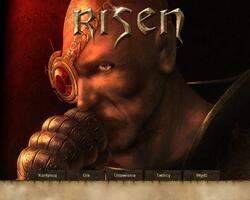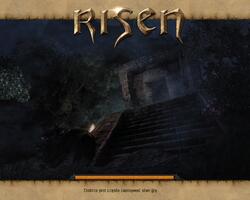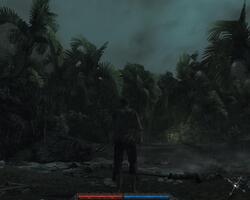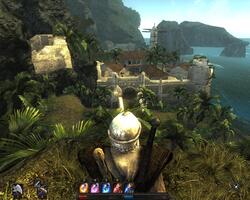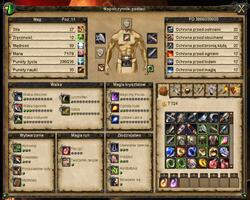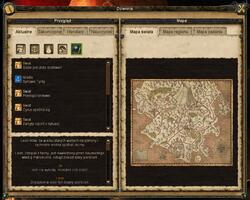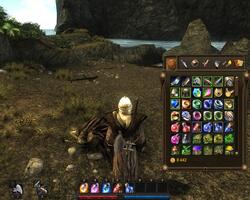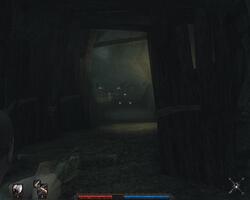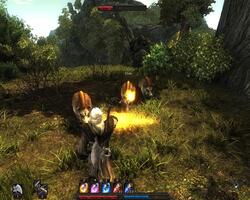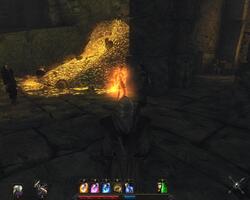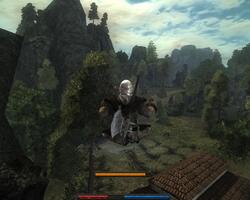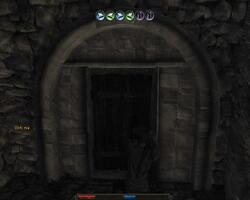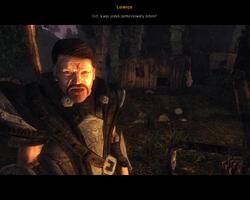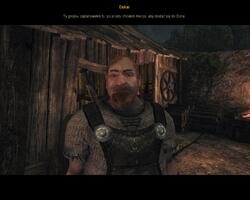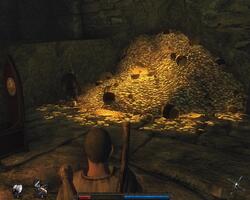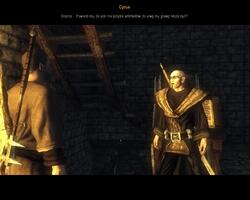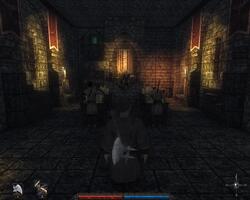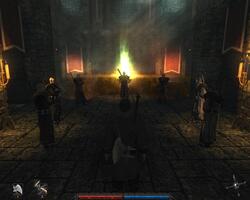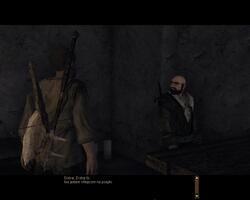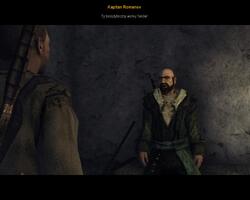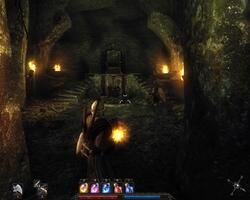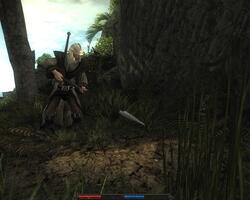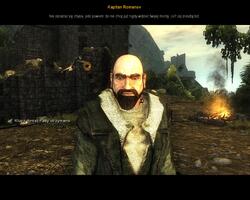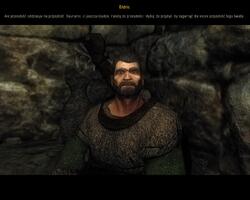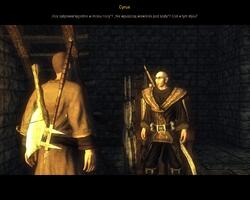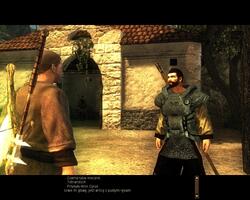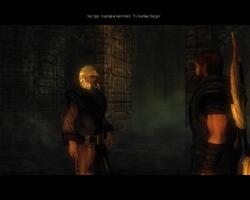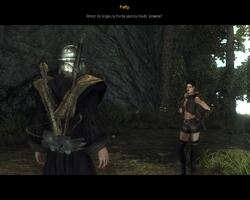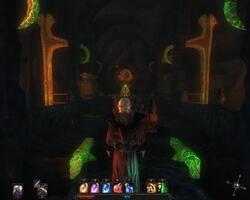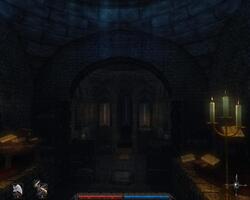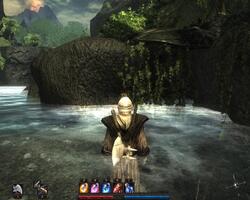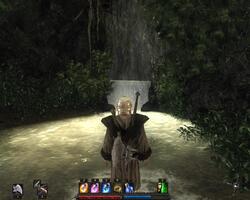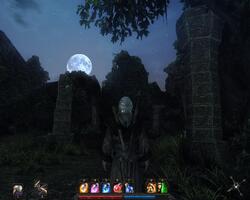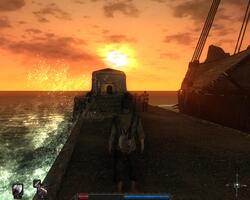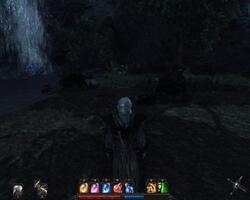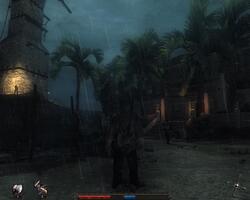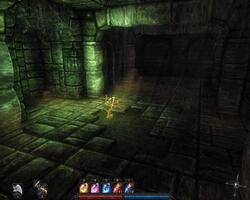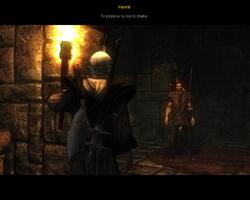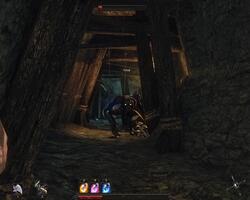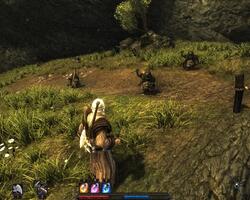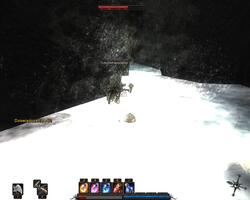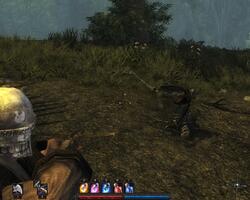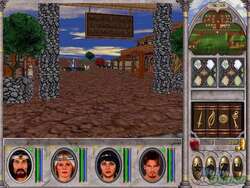Risen – probably the strongest deja-vu you’ll ever experience
Risen – probably the strongest deja-vu you’ll ever experience
Review - posted by DarkUnderlord on Sun 13 December 2009, 14:39:33
Tags: Piranha Bytes; RisenDarth Roxor takes a look at Risen, Piranha Bytes spiritual successor to the Gothic series. Is it all it's cracked up to be?
Read the rest here.
Now that we’re done with the background, I believe it’s time to focus on the meat of the game. Risen is divided into four chapters, and saying that they’re a mixed bag is an understatement. In the first one, you’ll need to swear allegiance to one of the factions, and generally, this one is the best from the ‘roleplaying’ perspective. I believe it has the most sidequests, and many of them have a few ways of approaching and finishing. Basically the whole Harbour Town is an exercise in choosing sides – the major quests found there are possible to finish in two ways, either for the inquisition or the Don. They mostly arise from a common problem, but then have multiple ways to do them, two ways to finish and different outcomes. For example, five pieces of valuable ceremonial armour have been misplaced somewhere. Both the inquisition and the rebels are looking for them, but only one man associated with the rebels knows where they all are. Three different people have the pieces, and you can either steal them, if you have the skill, beat them up if you feel capable, or buy them for insane prices. After you have them all, you can take the armour either to the inquisition or to the rebels, which yields you reputation, gold (the rebels usually pay better) and utility items (potions, scrolls). Depending on who you choose to support in these quests will also unlock new quests and teachers – for example, aiding the rebel Delgado not only gives you another, otherwise unavailable, quest, but he’s also the only person in the game who can teach you the third level of pickpocketing.
[...]
If you join the inquisition, you’ll end up in the monastery, where you’ll need to finish your basic training first. The monastery is also home to some of the most interesting quests in the game. For example, the first test you’ll have to pass, is the test of combat. You’ll need to beat three recruits first, and in the end challenge Master Aric, the combat trainer. You can approach Aric in two ways – if you grasped Risen’s combat really well already, you can try beating him fair and square, but it’s a tough fight. However, if you get beaten once, you can ask the other recruits for advice, and you’ll be able to drastically tip the scales in your favour by getting Aric drunk and replacing his fancy sword with a weak one. Another well done quest is the murder investigation – you’ll feel like in The Name of the Rose, gathering clues about the murder, interrogating witnesses, and eventually pretending to be a weed trader to lure out the murderer, who’ll turn out to be, well… someone you probably didn’t expect.
[...]
If you join the inquisition, you’ll end up in the monastery, where you’ll need to finish your basic training first. The monastery is also home to some of the most interesting quests in the game. For example, the first test you’ll have to pass, is the test of combat. You’ll need to beat three recruits first, and in the end challenge Master Aric, the combat trainer. You can approach Aric in two ways – if you grasped Risen’s combat really well already, you can try beating him fair and square, but it’s a tough fight. However, if you get beaten once, you can ask the other recruits for advice, and you’ll be able to drastically tip the scales in your favour by getting Aric drunk and replacing his fancy sword with a weak one. Another well done quest is the murder investigation – you’ll feel like in The Name of the Rose, gathering clues about the murder, interrogating witnesses, and eventually pretending to be a weed trader to lure out the murderer, who’ll turn out to be, well… someone you probably didn’t expect.
Read the rest here.
by Darth Roxor
DISCLAIMER: Since I played the localized version of Risen, all screenshots are in Polish. Some of the names I toss around might not be exactly the way they’re found in game (although I've done my best to find out their original names). Since rpgcodex.pl is a prestigious international magazine, I figured there’d be no harm done.
What is Risen?
Risen is a third-person action roleplaying game by Piranha Bytes, known mostly (and only) for their Gothic series. Gothic 1 and 2 (plus the Night of the Raven expansion) are widely acknowledged as some of the best ARpgs have to offer but the third installment of the franchise was a project too ambitious for its own good, and well, to put it mildly, it was somewhat lacking to say the least. Developers from PB claimed many times before releasing Risen that they have listened to the complaints from the fanbase, and that their new game was to go back to the roots of Gothic 1 / 2. Was it truth or empty hype-speech? Fortunately, the first one.
A long trip down memory lane
The moment you start the game, everything about it just screams ‘--->GOTHIC!!<---’. Here’s what Risen’s about: The sleeper Gods of the world have been banished by a powerful magician, but that caused an ancient evil to awake – the dragons Titans. You’re a nameless man, kicked into shipwrecked on a secluded prison colony island. The people living here are troubled by many problems, both external and political, since the awakening of the titans also caused ancient temples inhabited by orcs lizardmen and other deadly creatures to emerge from the ground. The monsters quickly spread across the island’s surface, and the farmers had to run to the only shelter available – Khorinis the Harbour Town ruled byGeneral Lee Don Esteban and his, often cruel and corrupt, mercenaries soldiers. This wasn’t to last long, though, as the temples attracted the attention of the paladins Inquisition lead by Lord Hagen Inquisitor Mendoza, who thought the ruins might contain the means to end the Titan threat. The Inquisition established their base of operations in the monastery of thefire mages Mages of the Holy Flame, who are the devout protectors of the island. The Inquisition also took control of Harbour Town, declared martial law and kicked the Don and his men out to the swamp, where they made an encampment right next to one of the major temples, and are now plotting to get back in control.
Also, the first enemies you meet are scavengers 2.0 sea vultures.
Sounds familiar? Of course it doesn’t.
Rise of a hero
After the beginning cinematic, you’re immediately thrown into hostile territory, so you’ll need to scavenge the beach for any potential weapons, supplies or survivors that might have left the shipwreck. The first character you meet is Sara – the only person (except you) that managed to survive. She’s also the in-game ‘tutorial’ so to speak, but fortunately her advice isn’t in the form of ‘Now press I to open the inventory, young Padawan (oh my, you’re learning fast!)’, but believable things such as ‘strap the weapon to your back to unsheathe it quickly’. After you find shelter, she tells you to go find some form of civilization, and after that you’re pretty much free to do what you please… if you survive.
Indeed, surviving is a tricky matter in the world of Risen. The whole island is swarming with creatures that would gladly see you as their dinner. The ruins are filled to the brim with lethal traps, and then there are warriors of the inquisition, who’ll beat you up and drag you to the monastery as a recruit if they find you. To have any hope of survival, you’ll need training… and allies.
As for training (just like in Gothic) to advance in abilities, you need to find a teacher first (they are also written down in the journal after meeting them), then pay him for training. Above all, you need to have skill points that you get after achieving new levels. There are quite a number of different abilities to get. Some more, some less useful, but they all serve their purposes, and there’s only one that I’d call downright useless.
The physical stats are strength (higher damage with melee weapons), dexterity (higher damage with ranged weapons), wisdom (this cannot be ‘learned’ per se, it increases through reading books and ancient tablets. It’s needed to understand runic magic), mana (used for spellcasting) and hit points (these rise with every level).
There are also the weapon skills, and there are eight of them – three for melee weapons (swords, axes, staves), two for ranged weapons (bows, crossbows) and three for magic crystals (fireball, ice lance, magic bullet).
And the last are the ‘minor’ skills, such as alchemy, smithing, prospecting, hunting, scroll scribing, runic magic, lockpicking, pickpocketing, sneaking and acrobatics.
Before describing the weapon skills in detail, combat itself should be addressed. Well, it’s hard. Or at least depending on your play style. Like in Gothics, you can chain attacks into combos, but it requires timing your left mouse button clicks or you’ll swing at a snail’s pace, which will leave large windows of opportunity between your attacks that your enemies can (and will) use to their advantage. Attacks no longer hit only one creature, but all in range, so (unlocked later) side attacks are great to decimate whole mobs of enemies, especially with two-handed weapons. The enemy AI is also not bad – when attacking in groups some will try to flank you; humanoids with actual weapons will block a lot, and when facing groups of these it’s not rare for one of them to focus your attacks and block, while the other one delivers the blows. It’s also important to note that you’re not the only one with special moves unlocked through weapon training – enemies will use power attacks and counterattacks the best they can. The fact that most enemies are block-maniacs will also force you to employ tactics different than just ‘click till they die’ – dodging around and provoking them to attack or using power attacks to break their block is often more important than having 100 strength and Sword of Awesome +6.
But as I said, the difficulty will vary for different characters – I played through three times, once with a pure-melee staff fighter (which was hell on earth), once with a bowman (which was piss-easy) and once with a mage (which was… moderate).
As for the weapon types and skills, let’s start with the melee ones. Generally, advancing in melee weapon skills will give you a new set of moves or abilities, such as wielding two-handed weapons in one hand, the ability to use power attacks (these need a while to charge, but they do a lot better damage and range than normal ones and break enemy blocking), counterattacks (interrupt an enemy’s attack and leave him vulnerable to a hit), side attacks (a bit shorter range, but good for crowd control), additional attacks to your combos or just plain better damage or speed.
Swords are the most common weapon you’ll find in Risen. They come in three different types – normal ones (also called ‘light weapons’, because maces, clubs etc also fall into this category), bastards and two-handers. At the start, bastards and two-handers are two-handed, but progressing in the sword skill allows you to wield them in one hand. Light weaponry has the lowest strength requirement and highest attack speed, but also the lowest damage and range, while two-handers are the exact opposite, and bastards are somewhere in between.
While the skill itself is called ‘axe fighting’, the weapons falling into this category are called ‘heavy weaponry’ in-game, since they’re not only axes, but also hammers (this is like Oblivion all over again!!). All heavy weapons are two-handed, but as with swords, advancing in the skill enables wielding them in one hand. They all have a rather big strength requirement and are very slow, but in return they have enormous damage, and the speed can be countered a bit later due to training.
Staves are all two-handed, and they are the only melee weapon that cannot be wielded in one hand through training. Compared to swords and axes, staves have a rather low damage and their attack speed is moderate, but they have the longest range and can be particularly deadly with side and power attacks.
Now, I’d really like to say that all of the melee weapons are balanced properly and there’s no ‘better than the others’ option, but unfortunately that’s not the case. Swords are lying around almost everywhere throughout the game, while I think the only source of more powerful axes are merchants, and staves are particularly neglected – the best staff you can get before the (last) fourth chapter is a glaive (that you even have to steal in the first place) that has 50 damage – compared to axes that are available at the time, which I think already have damage ranging to 80 – and even at the start of chapter 4, there’s only one merchant that sells better staves, and he has a quite high chance of dying due to spoiler-related events (but fortunately, two better staves can be found… in end-game dungeons…). Moreover, since staves are the only weapons that can’t be wielded in one hand, you can’t use shields that absorb quite a lot of damage later on and make blocking easier, and the damage absorption would seriously come in handy, since staves are actually rather slow, and you’ll be taking a lot of hits if you don’t focus on any ranged combat. All in all, the rather obvious underpowering of staves is a real damn shame, because I liked the idea of making them something more than just ‘Staff? You mean the sucky 1d6 starter weapon in the infinity engine games?’.
Also, you can find pieces of two weapons that you can reforge later if you have high enough smithing. Guess what these two weapons are. Yup, they’re swords.
Ranged weapons are more straight-forward. Each additional level in these skills increases damage and decreases reload time by 10%, although it seemed like a bit of a hoax to me, since you can barely feel the difference between certain levels, but when the skill is maxed out, you suddenly start shooting with machinegun speed. Scoring hits on ‘vital points’ (read: headshots) adds more damage.
The comparison between bows and crossbows is pretty basic – bows require dexterity and are moderately fast, while crossbows require strength and are slow as hell but have great damage. Crossbows also have no crosshair to aim when you are just running around with them, so you need to zoom in to sniper mode to aim properly, which limits your mobility a lot.
While I never maxed crossbows, bows at the highest skill level are nothing short of deadly, and my bowman character was the most amusing to use – for example, there’s one rather big underground compound full of lizardmen warriors (think of them as something like Gothic’s orcs) in the game. With the melee fighter, I needed to carefully pull the enemies to fight a maximum of 2 or 3 at once, or I’d be eaten alive before I could say ‘repeated power attacks to the face’, while with the bowman, I could start shooting all 10 of them thanks to the fact that I had a rather long tunnel behind me, through which I could run and shoot the chasers at the same time, and usually four headshots were enough to take a lizard down.
The last ‘weapon’ skills are magic crystals. There are three of them: fireball, frost lance and magic bullet. Like with ranged weapons, each level adds damage and lowers the reload time by 10%.
Fireball has the highest damage, a moderate mana cost, but it charges and flies the slowest of all crystals. Fireball also has a blast radius that increases as you advance in the skill.
Frost lance has moderate damage and reload time, but the highest mana cast. The offset is the ability to freeze enemies for a short period of time (increasing through training) - which makes for great crowd control, since you can quickly lower the number of potential threats how you see fit - although some creatures (like ashbeasts) are particularly resistant to freezing.
Magic bullet has the lowest mana cost and recharge time, but the lowest damage. Remember when I said there’s only one useless skill in the game? That’s magic bullet. I can hardly find any use for it, that the other crystals wouldn’t do much better. The mana cost might seem the lowest, but in reality, when you do the math, it’s actually the highest, because the crystal’s damage is so pitiful, that I think shooting three magic bullets (15 mana) is basically the equivalent of one fireball (8 mana), not to mention the fireball’s area-damage.
While we’re on the subject of magic, I think it would be fine to expand on the whole aspect. Unfortunately, magic isn’t well-developed, I must say. There are three ‘vessels’ of spells: scrolls (can be used only once, available to all factions), crystals (available to warriors of the order and mages) and runes (basically, infinite versions of scrolls, although they cost more mana). Except for the damage-dealing crystals, you’ll barely ever have any use for scrolls and runes other than the gimmicky ones that are needed to disarm traps (telekinesis) in dungeons or get into unavailable areas (meatbug nautilus transformation, levitation), since most of them are pretty bad, especially the healing spells that are vastly inferior to healing potions. When playing the mage, the only runes I used (other than aforementioned gimmicks) were berserk (increases melee damage, stopped using after I maxed out crystal magic), magic protection (+ armour), and haste (faster running, scrolls with this are incredibly hard to come by, too), and even that was actually rather rare. Other runes are, for example, skeleton summoning (basically, meatshield summoning, but the skeleton is so fragile it’s not worth it), ashbeast transformation (you get tons of +health, armour and damage, but the fact that you lose all special moves and ranged attacks makes it not worth it), inferno (drop a nuke on your enemies. Insane mana cost. Not worth it) and illusion (summons a vision of a half-naked dancer. Useful to distract guards from their posts, but you won’t be using it too often).
The ‘minor’ skills are pretty neat and good to have, they mostly function like the ones in Gothic, but with slight improvements.
Alchemy allows to brew various potions, from mana/health restoring to powerful ones that permanently increases stats. The stat-increasing ones need the highest (third) level of the skill, but it’s well-worth it, since you spend 15 skill points on it, while you can find more than 10 but less than 15 (I think) hero’s crowns, which are the plants needed for every stat-increasing potion, and these come in four different flavours - +5 strength/mana/dexterity and +10 health.
Smithing allows you to forge weapons (swords of all three types) and magic jewelry, so if you don’t use swords, the artifacts alone are worth it, since at max smithing you can craft such neat, and otherwise unavailable, things, like an amulet that gives +2 to all crystal skills, or another with +10 to dexterity and + 2 to bow usage.
Prospecting allows you to dig after minerals (gold for jewelry, ore for weapons, obsidian for better weapons). Additionally, each patch of minerals has a small chance to contain gems needed for the jewelry.
Hunting allows you to collect trophies from dead enemies, but along with the skill you also need the proper tools. Trophies can be sold for gold, but often they’re also ingredients needed to scribe scrolls.
Runic magic allows you to use more powerful runes, and scribing scrolls lets you, well, scribe magic scrolls. To make a scroll you need a blank scroll, a corresponding rune and special ingredients (for example, skeleton summoning requires a bone).
Lockpicking is pretty vital, unless you want to carry around hundreds of scrolls of opening, which is, needless to say, costly and inefficient. The action itself is basically the same as in Gothic – you approach a chest and press left or right a certain amount of times to open it.
Pickpocketing allows you to take a peek inside someone’s belongings. Actually, it’s most useful function is that you can go as far as take someone’s current weapon, which while downright ridiculous, especially when talking to warriors of the inquisitions who walk around with their staves in-hand, is good when you know that you’re going to fight that person in the future, so you can tip the scales by disarming the bastard. Pickpocketing is also handy in quite a few quests that would otherwise require you to pay gold for something, or run boring errands or beat someone up.
Acrobatics lowers the damage you take from falling. You thought acrobatics in Gothic were rather ridiculous? Well, think again. The damage reduction from this skill is so high, that quite often it’s easier to just save time and jump off a very high cliff to get to your destination, than to take the ’safe’ way around and walk.
Sneaking is actually useful only in the first chapters when you’re operating mostly in cities, with all the unsuspecting houses waiting to be pillaged, since you can’t really sneak by enemies or do stealth-related attacks or things like that.
Well then, character statistics aside, let’s return to the matter of allies and factions. The developers tried to make all the factions morally ambiguous, and I think they succeeded. There are no good guys – everyone has his own agenda which he’ll pursuit through any means necessary. The faction exposition is also done in an interesting way – with the inquisition, you’ll first be meeting the ‘good guys’ mostly, but after joining, suddenly you’ll start noticing that something’s not right about them. It’s the other way around for the rebels – if you go to Harbour Town first, instead of the rebel camp, you’ll be meeting the ‘criminal’ part of the organization mostly, and only later you’ll meet their local leader, who seems like a very reasonable chap.
The inquisition arrived on the island to investigate the risen temples. Meanwhile, they also thought establishing law and order in the corrupt land might be a good idea. So they kicked Don Esteban and his soldiers to the swamp, established martial law, drove out the farmers from their homes and locked them up in the city. Everyone who opposed them, criminals and drifters were sent to the monastery for forced recruitment. On one hand, the inquisition claims that they’re doing it all for the good of the people – the farmers wouldn’t have any chance to survive in the countryside, the city is better off without the Don, and criminals are made useful to the society (although many call it brainwashing). Moreover, when you do errands in the city, members of the order really seem to be the ones helping the people by punishing thievery, weed-trade and usury.
But on the other hand, after playing a bit, you’ll notice that they’re nothing but a fancy KKK, full of fanatics ready to jump in the fire if the inquisitor told them to do so, and the inquisitor himself would sacrifice everything around him to achieve his mysterious goals. If you choose to side with the Don, and then go to the monastery, you’ll have a chance to speak with the recruits, and most of them will envy your freedom.
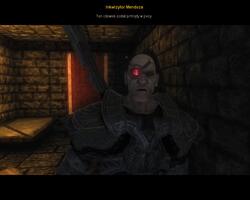
The inquisitor. You can tell he’s not a lunatic by the baldness and monocle. He’s also voiced by Gollum.
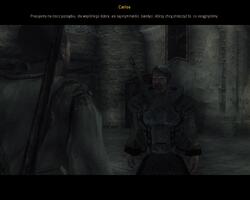
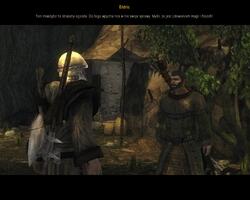
The second group is Don Esteban’s lot. Ever since they were driven out to the swamp, they’ve been trying to take back the Harbour Town for themselves – the Don is hoarding wealth, to buy people back, and his men are infiltrating the town doing various mischief to make the inquisition’s life less happy. They’re a motley bunch, full of opportunistic scoundrels and cutthroats, and you’ll meet most of such in the city. However, the Don himself is generally respected among everyone – even some members of the inquisition – as a fair man. Cruel at times, but fair. While some of his underlings are downright scum, like Brogar, one of his leftenants, who keeps everyone under his boot, there are also people who are true fighters for the cause, like the leader of those dispatched to the city, Scordo.
The last are the mages. They’ve been the island’s protectors ever since their order has been started. After the inquisition arrived, they’ve just stepped aside, allowed them to set up a headquarters in their monastery, and generally turned a blind eye to some of the inquisition’s questionable deeds. Now, while they’re not ‘bad’ in any way, they’re perhaps guilty of the worst crime – the indifference. In the Don’s camp you’ll find a ‘renegade’ mage who points you to this – he says the monastery was once a place of peace and scholarship, but now it has turned into nothing but barracks for the inquisition.
Chapters from a vale forlorn
Now that we’re done with the background, I believe it’s time to focus on the meat of the game. Risen is divided into four chapters, and saying that they’re a mixed bag is an understatement. In the first one, you’ll need to swear allegiance to one of the factions, and generally, this one is the best from the ‘roleplaying’ perspective. I believe it has the most sidequests, and many of them have a few ways of approaching and finishing. Basically the whole Harbour Town is an exercise in choosing sides – the major quests found there are possible to finish in two ways, either for the inquisition or the Don. They mostly arise from a common problem, but then have multiple ways to do them, two ways to finish and different outcomes. For example, five pieces of valuable ceremonial armour have been misplaced somewhere. Both the inquisition and the rebels are looking for them, but only one man associated with the rebels knows where they all are. Three different people have the pieces, and you can either steal them, if you have the skill, beat them up if you feel capable, or buy them for insane prices. After you have them all, you can take the armour either to the inquisition or to the rebels, which yields you reputation, gold (the rebels usually pay better) and utility items (potions, scrolls). Depending on who you choose to support in these quests will also unlock new quests and teachers – for example, aiding the rebel Delgado not only gives you another, otherwise unavailable, quest, but he’s also the only person in the game who can teach you the third level of pickpocketing.
If you join the inquisition, you’ll end up in the monastery, where you’ll need to finish your basic training first. The monastery is also home to some of the most interesting quests in the game. For example, the first test you’ll have to pass, is the test of combat. You’ll need to beat three recruits first, and in the end challenge Master Aric, the combat trainer. You can approach Aric in two ways – if you grasped Risen’s combat really well already, you can try beating him fair and square, but it’s a tough fight. However, if you get beaten once, you can ask the other recruits for advice, and you’ll be able to drastically tip the scales in your favour by getting Aric drunk and replacing his fancy sword with a weak one. Another well done quest is the murder investigation – you’ll feel like in The Name of the Rose, gathering clues about the murder, interrogating witnesses, and eventually pretending to be a weed trader to lure out the murderer, who’ll turn out to be, well… someone you probably didn’t expect.
One more fine chain of quests that deserves mentioning is found at the rebel camp. I already mentioned Brogar, one the Don’s leftenants. Well, it turns out that he has ambitions to take the Don’s place, and he runs a campaign of intimidation in the camp. Everyone fears him, he’s ‘illegally’ collecting protection money from people, and doesn’t allow the hunters to gather food, so everyone is starving. Your task will be to teach Brogar a lesson and gather evidence against him, so Don’s wife – Rachel, who’s actually the one running the camp, because the Don is barely ever leaving his treasure trove – can have the excuse to get rid of Brogar once and for all.
However it’s a shame that some of the quests leave loose ends that beg for interesting consequences, which either never happen or are rather lackluster. For example the monastery murder investigation. If you don’t kill the murderer and report him to the mages, he’s locked up. But a few days later you’re informed that he escaped custody and you should watch your back. You never meet him again.
A similar thing happens with Brogar. After you finish the business with him, he vows to eventually get even with you. And indeed, in the later chapters, you’ll find him again, but the encounter is laughable. You see, one of the parts of the Brogar questchain in the first chapter involves beating him up on the local arena, and when you knock someone out and take his weapon in Risen, he gets up with a 10-damage club… and it stays that way forever, so in the last chapter, you find Brogar doing a Gandalf-ish ‘you shall not pass’, after which he tries to beat you with a stick.
And these are only two aftermaths (or lack thereof), while many more quests leave such loose ends.
While the first chapter was mostly RP-oriented, the second one is probably the one where you’ll be doing the most exploring, because the whole world lies before you, and there are quite a few quests that will require you to travel into every corner of the island. For example, you meet a man who tells you that someone who calls himself Lord Patroscon is haunting his dreams, and all that started after he looted some ring from a local ruin, so you’re sent to other ruins across the isle to collect the other rings from various undead lords, and in the end you challenge Patroscon himself.
There’s also another quest that revolves around digging after treasures left by a famous pirate, and ends with a damsel-in-distress scenario, that also has three ways of approaching it.
As far as writing and voice-acting go, well, the writing’s ok, and the voice-acting is top notch.
You’ll hear many different accents, from British, to Irish and Scottish, the actors approached their work very professionally, and the two heads of the factions are voiced by Andy Serkis (the inquisitor) and John Rhys-Davies (the Don), although there always are some silly moments. Like for example, when you’re accompanied by one of the head mages – Master Cyrus – he keeps yelling “YES! Good stuff!!” after enemies die, which sounds remarkably ridiculous.
As for the writing, don’t expect any high-brow philosophy, but it’s also not cringe-worthy either. Some dialogue lines are witty, others sarcastic, others blunt and colloquial but mostly they’re just plain functional, but at least they’re believable. Although I liked the lines for the main character, who, just like in Gothics, stays a sarcastic fellow throughout the game, even if he is on the mission to save the world, and there’s no stupid and pseudo-epic ‘I shall smite thee, villain’, which I think is a huge plus. I also spotted a Monty Python reference once, after a quest to kill a legendary creature, the character says ‘Dead. Deceased. This is a dead Gyrger’. I also couldn’t help but smile, when I’ve been asked for some kind of a password once, and one of the dialogue options was ‘Tetriandoch’.
It’s also interesting to note that the game has two versions of writing – one was done for the German version and the other for international versions, was done among others, by Rhianna Pratchett.
Now, after chapter two ends, many people start pointing out their dissatisfaction (or even general hate) with Risen, because the last two chapters are pretty much nothing but dungeon crawls, so both the roleplaying options of chapter one and the exploration of chapter two are taken away. Your enjoyment of the last two chapters will be determined by one factor: how much you like the combat. Personally, I thought chapters three and four, while a bit inferior to one and two, were also pretty great, because not only are they mostly full of challenging fights (especially chapter three), but I think the combat system in Risen is the best ARPG combat system ever made, it’s even better than the one in Gothics, mostly thanks to the added variety of special moves, not to mention that the end-game dungeons are also pretty interestingly designed – you’ll have to constantly observe your surroundings, because they’re full of lethal traps, so if you get careless, you’ll be smashed by crushers, impaled by spike traps, burned alive by incinerators and dropped in the middle of enemy mobs by trapdoors. Some areas even have additional assholery in the form of anti-magic crystals around the walls, which doesn’t allow the use of any magic.
Also, in the fourth chapter, you will probably have already maxed out at least two stats, which makes you a walking death-dealing machine, and the massive killing capacity of max level fireballs or bow is just downright amusing to watch (but that doesn’t mean that you’re immortal. There’ll still be quite a lot of encounters that will be more than capable of taking you out).
The only thing that’s absolutely fucking horrible with chapter four, is the very end, and by very end, I mean the boss fight, which is basically one giant, anticlimactic, uninspired and dull minigame. I’d say it’s right up there with System Shock 2’s end-game ‘Nah’.
Bunnyhopping through the wilderness
Since most of the time you’ll spend in-game will be exploring, writing down a few paragraphs on the gameworld is important. The Mediterranean-style island is built very well. There’s content to see on every step and while going through the countryside, you’ll have moments of ‘ooooh, I wonder what’s over there’ nearly constantly. Unfortunately, it’s relatively small (I’d say it’s comparable, or even a little smaller than the world of Gothic 1), so sometimes you might get the impression that things are cramped on top of each other, and it leads to some silly things like deadly monsters living five steps from human settlements or wild animals like wolves living in perfect symbiosis and understanding with sea vultures, as documented in one of the screenshots.
What I liked, was the fact that exploring at night actually makes for a whole new experience, I might say. During night time, most wild animals fall asleep, so while it makes it easier to sneak next to them without provoking a fight, it also provides a few fun surprises, when you accidentally step on a wolf in the high grass. Not to mention the world just looks gorgeous, both in daylight and at night. While running through the wilderness, you’ll be accompanied by the mellow, ambient soundtrack, which was done by Kai Rosenkranz, who’ll some of you might know from doing the soundtrack to Gothics, and well, there’s even one theme that sounds a bit recycled, and that’s the swamp theme from G1, which is, again, used at the swamp.
In your travels, you’ll find various ruined forts, ancient temples, caves and points of interest in the thick forests, full of hidden passages, caches of supplies, rare plants… and dangers.
And dangers are common in Risen. I already mentioned the traps, now it’s time for monsters. There are quite a few of them that you’ll HATE, and I mean HATE with a passion, mostly three of them: gnomes, ghouls and brontoks. Gnomes are not particularly deadly, but they’re annoying as hell, because the whole island is swarming with them, and they always attack in groups of four or more (the largest I remember had about twelve). Ghouls, now they are a pain in the ass. Not only are they very fast, but I think they also have a high resistance to magic and piercing damage. They hit hard and have a special attack – if you block their attacks, they cast a kind of ice burst that breaks your block and takes down a lot of HP. And brontoks… they look a bit like armoured buffalos, and these are especially annoying to melee fighters, because they’re the only monsters in game that can cause ‘stunlocks’, since each of their attacks breaks your block/knocks you back, and they can chain up to 4 such attacks. Moreover, they can parry your hits.
There are also monsters such as ogres or ashbeasts, that are basically the toughest in game, with tons of health and extremely powerful melee attacks that can instakill you even at relatively high levels.

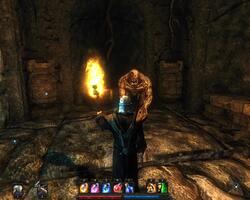
High ground, we’ll gain the advantage! / Undead Ashbeast. Just when you thought the normal one is tough.
So after dangers, monsters and instakilling, it’s time to address armour. While it does a good job at keeping you alive for more than 5 seconds, it definitely doesn’t give as much IDDQD as the armour in Gothic did, because let’s face it, once you had heavy digger trousers, scavengers could barely scratch you. Here, even when you have mid-game suit of armour, a horde of wolves will be able to kill you if you are careless. Armour has six protections: from slashing, piercing and blunt damage and magic fire, frost and projectiles. Now, that’s all fine and dandy, but… I can count magic-using enemies on two fingers, and these are lizardmen priests that toss fireballs, and the ghouls using ice burst. You won’t meet any enemy throwing magic bullets, so basically, all amulets that give +armour against elemental damage are completely useless. This is also a shame because it shows that you’ll mostly be fighting enemies in melee, because truth be told, even those with physical ranged attacks are rather scarce, and this is another argument in favour of using bows/crystals instead of focusing on melee only.
Also, in the title of the section I mentioned ‘bunnyhopping’. Prepare to do that a lot, because running speed is pretty slow, and scrolls of haste are ridiculously hard to find, and jumping (which has a pretty silly animation) makes traveling a lot faster. Fortunately though, later in the game you’ll start finding teleportation stones that will take you to specific parts of the map instantly.
Technical stuff
Everyone’s greatest fear prior to playing Risen was probably whether it would be as unoptimised and bug-ridden as Piranha Bytes’ last product – Gothic 3 – was. Fortunately, it’s not. The optimization is one of the best I’ve seen in years, and I feel obliged to give really solid kudos to the PB team, because the game not only looks very, very pretty, but it also works like a charm. I don’t remember having a single crash to desktop. I’ve been playing on full details on my GeForce 8800 GTS, 2.33ghz core 2 duo and 2GB ram, and I didn’t get asingle drop in performance, while many other new games keep getting hiccups even on medium settings on my rig. Although it should be noted that some people reported having performance issues due to having ‘too new’ graphics card drivers (or something like that, can’t quite remember), but I think it got patched already.
Before playing, though, take my advice and disable depth of field in the options menu, as it takes a lot away from the sightseeing. Why do developers keep putting this crap into games is beyond me. There are also some character models that look awful, and by ‘awful’ I don’t even mean ‘they’re ugly people’, because they’re just... ‘alien’.
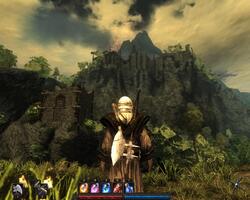

Depth of field on...and off. Find five differences
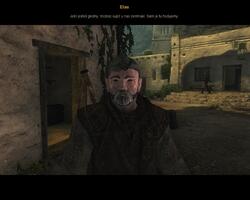
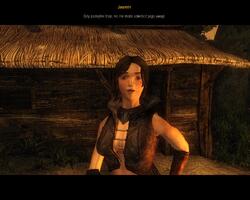
Hello there, awkward looking male model / Greetings, strange female character
Last graphical complaint is the fact that some areas are just overdone with bloom, especially splashing water, which makes fighting in it a blinding experience.
As for bugs, they are there, even quite a few, but they’ll mostly make you laugh more than rage. Although the rage kind are present they are, fortunately, rare. For example, the physics engine sometimes goes bananas, which leads to some lovely ‘phun with fysics’, like enemies skyrocketing after dying in melee (documented in screenshot). Of course, there are also the ever-present clipping issues. Some dialogues and descriptions also have mistakes – for example, you find a novice who tells you a mage sent him and his companion – Krayban – to gather some plants, but now Krayban has gone missing... except that he’s 5 steps behind him, sitting at a campfire. He actually goes missing later, when you get the same task from the mage, and when you find the guy’s corpse, you find ‘Krayban’s ring’ on him, that’s described as ‘I found this ring on Barry’s corpse’. Most interesting. In a few places you’ll find force fields, that can be removed only through magic, but when you try to bash them in melee at point blank range, you may also slip past them. Another rather peculiar bug happened when I was shooting a lizardman warrior that was standing on the other end of a chasm. When he got hit, he suddenly started running backwards at lightning speed, and disappeared inside a wall. In another scenario that looked exactly the same, the two lizardmen I was shooting suddenly started ‘teleporting’ up and down along a perfectly vertical ledge...
As for the more irritating bugs, sometimes when you end the levitation spell, you get blown away into the air, which may cause serious injury upon landing. I also heard it’s possible to get gamebreaking bugs in the monastery murder quest and the initiation to the inquisition/mages, but I’ve never encountered these personally, so I can’t comment on how true they are.
There are probably some more about which I’ve forgotten, but as I said, I didn’t encounter any that would be absolutely gamebreaking, so that’s a plus.
Deja-vu ain’t what it used to be
I’m aware some people might hate Risen after chapter two, some will probably hate it completely, but I must say that I really had a splendid time with this game, with all three playthroughs being somehow different and exciting, despite some of the shortcomings.
And in the end, the question still stands: is Risen a worthy spiritual successor to the Gothic series? Hell yes, if you want another injection of Gothic, Risen is definitely what you’re looking for, since it’s the same formula, but in a new engine, some new ideas and a lot of improvements. If you never liked any game from Piranha Bytes, though, you should avoid it like the plague, because there’s nothing new that would make you enjoy it.
DISCLAIMER: Since I played the localized version of Risen, all screenshots are in Polish. Some of the names I toss around might not be exactly the way they’re found in game (although I've done my best to find out their original names). Since rpgcodex.pl is a prestigious international magazine, I figured there’d be no harm done.
What is Risen?
Risen is a third-person action roleplaying game by Piranha Bytes, known mostly (and only) for their Gothic series. Gothic 1 and 2 (plus the Night of the Raven expansion) are widely acknowledged as some of the best ARpgs have to offer but the third installment of the franchise was a project too ambitious for its own good, and well, to put it mildly, it was somewhat lacking to say the least. Developers from PB claimed many times before releasing Risen that they have listened to the complaints from the fanbase, and that their new game was to go back to the roots of Gothic 1 / 2. Was it truth or empty hype-speech? Fortunately, the first one.
A long trip down memory lane
The moment you start the game, everything about it just screams ‘--->GOTHIC!!<---’. Here’s what Risen’s about: The sleeper Gods of the world have been banished by a powerful magician, but that caused an ancient evil to awake – the dragons Titans. You’re a nameless man, kicked into shipwrecked on a secluded prison colony island. The people living here are troubled by many problems, both external and political, since the awakening of the titans also caused ancient temples inhabited by orcs lizardmen and other deadly creatures to emerge from the ground. The monsters quickly spread across the island’s surface, and the farmers had to run to the only shelter available – Khorinis the Harbour Town ruled by
Also, the first enemies you meet are scavengers 2.0 sea vultures.
Sounds familiar? Of course it doesn’t.
Rise of a hero
After the beginning cinematic, you’re immediately thrown into hostile territory, so you’ll need to scavenge the beach for any potential weapons, supplies or survivors that might have left the shipwreck. The first character you meet is Sara – the only person (except you) that managed to survive. She’s also the in-game ‘tutorial’ so to speak, but fortunately her advice isn’t in the form of ‘Now press I to open the inventory, young Padawan (oh my, you’re learning fast!)’, but believable things such as ‘strap the weapon to your back to unsheathe it quickly’. After you find shelter, she tells you to go find some form of civilization, and after that you’re pretty much free to do what you please… if you survive.
Indeed, surviving is a tricky matter in the world of Risen. The whole island is swarming with creatures that would gladly see you as their dinner. The ruins are filled to the brim with lethal traps, and then there are warriors of the inquisition, who’ll beat you up and drag you to the monastery as a recruit if they find you. To have any hope of survival, you’ll need training… and allies.
As for training (just like in Gothic) to advance in abilities, you need to find a teacher first (they are also written down in the journal after meeting them), then pay him for training. Above all, you need to have skill points that you get after achieving new levels. There are quite a number of different abilities to get. Some more, some less useful, but they all serve their purposes, and there’s only one that I’d call downright useless.
The physical stats are strength (higher damage with melee weapons), dexterity (higher damage with ranged weapons), wisdom (this cannot be ‘learned’ per se, it increases through reading books and ancient tablets. It’s needed to understand runic magic), mana (used for spellcasting) and hit points (these rise with every level).
There are also the weapon skills, and there are eight of them – three for melee weapons (swords, axes, staves), two for ranged weapons (bows, crossbows) and three for magic crystals (fireball, ice lance, magic bullet).
And the last are the ‘minor’ skills, such as alchemy, smithing, prospecting, hunting, scroll scribing, runic magic, lockpicking, pickpocketing, sneaking and acrobatics.
Before describing the weapon skills in detail, combat itself should be addressed. Well, it’s hard. Or at least depending on your play style. Like in Gothics, you can chain attacks into combos, but it requires timing your left mouse button clicks or you’ll swing at a snail’s pace, which will leave large windows of opportunity between your attacks that your enemies can (and will) use to their advantage. Attacks no longer hit only one creature, but all in range, so (unlocked later) side attacks are great to decimate whole mobs of enemies, especially with two-handed weapons. The enemy AI is also not bad – when attacking in groups some will try to flank you; humanoids with actual weapons will block a lot, and when facing groups of these it’s not rare for one of them to focus your attacks and block, while the other one delivers the blows. It’s also important to note that you’re not the only one with special moves unlocked through weapon training – enemies will use power attacks and counterattacks the best they can. The fact that most enemies are block-maniacs will also force you to employ tactics different than just ‘click till they die’ – dodging around and provoking them to attack or using power attacks to break their block is often more important than having 100 strength and Sword of Awesome +6.
But as I said, the difficulty will vary for different characters – I played through three times, once with a pure-melee staff fighter (which was hell on earth), once with a bowman (which was piss-easy) and once with a mage (which was… moderate).
As for the weapon types and skills, let’s start with the melee ones. Generally, advancing in melee weapon skills will give you a new set of moves or abilities, such as wielding two-handed weapons in one hand, the ability to use power attacks (these need a while to charge, but they do a lot better damage and range than normal ones and break enemy blocking), counterattacks (interrupt an enemy’s attack and leave him vulnerable to a hit), side attacks (a bit shorter range, but good for crowd control), additional attacks to your combos or just plain better damage or speed.
Swords are the most common weapon you’ll find in Risen. They come in three different types – normal ones (also called ‘light weapons’, because maces, clubs etc also fall into this category), bastards and two-handers. At the start, bastards and two-handers are two-handed, but progressing in the sword skill allows you to wield them in one hand. Light weaponry has the lowest strength requirement and highest attack speed, but also the lowest damage and range, while two-handers are the exact opposite, and bastards are somewhere in between.
While the skill itself is called ‘axe fighting’, the weapons falling into this category are called ‘heavy weaponry’ in-game, since they’re not only axes, but also hammers (this is like Oblivion all over again!!). All heavy weapons are two-handed, but as with swords, advancing in the skill enables wielding them in one hand. They all have a rather big strength requirement and are very slow, but in return they have enormous damage, and the speed can be countered a bit later due to training.
Staves are all two-handed, and they are the only melee weapon that cannot be wielded in one hand through training. Compared to swords and axes, staves have a rather low damage and their attack speed is moderate, but they have the longest range and can be particularly deadly with side and power attacks.
Now, I’d really like to say that all of the melee weapons are balanced properly and there’s no ‘better than the others’ option, but unfortunately that’s not the case. Swords are lying around almost everywhere throughout the game, while I think the only source of more powerful axes are merchants, and staves are particularly neglected – the best staff you can get before the (last) fourth chapter is a glaive (that you even have to steal in the first place) that has 50 damage – compared to axes that are available at the time, which I think already have damage ranging to 80 – and even at the start of chapter 4, there’s only one merchant that sells better staves, and he has a quite high chance of dying due to spoiler-related events (but fortunately, two better staves can be found… in end-game dungeons…). Moreover, since staves are the only weapons that can’t be wielded in one hand, you can’t use shields that absorb quite a lot of damage later on and make blocking easier, and the damage absorption would seriously come in handy, since staves are actually rather slow, and you’ll be taking a lot of hits if you don’t focus on any ranged combat. All in all, the rather obvious underpowering of staves is a real damn shame, because I liked the idea of making them something more than just ‘Staff? You mean the sucky 1d6 starter weapon in the infinity engine games?’.
Also, you can find pieces of two weapons that you can reforge later if you have high enough smithing. Guess what these two weapons are. Yup, they’re swords.
Ranged weapons are more straight-forward. Each additional level in these skills increases damage and decreases reload time by 10%, although it seemed like a bit of a hoax to me, since you can barely feel the difference between certain levels, but when the skill is maxed out, you suddenly start shooting with machinegun speed. Scoring hits on ‘vital points’ (read: headshots) adds more damage.
The comparison between bows and crossbows is pretty basic – bows require dexterity and are moderately fast, while crossbows require strength and are slow as hell but have great damage. Crossbows also have no crosshair to aim when you are just running around with them, so you need to zoom in to sniper mode to aim properly, which limits your mobility a lot.
While I never maxed crossbows, bows at the highest skill level are nothing short of deadly, and my bowman character was the most amusing to use – for example, there’s one rather big underground compound full of lizardmen warriors (think of them as something like Gothic’s orcs) in the game. With the melee fighter, I needed to carefully pull the enemies to fight a maximum of 2 or 3 at once, or I’d be eaten alive before I could say ‘repeated power attacks to the face’, while with the bowman, I could start shooting all 10 of them thanks to the fact that I had a rather long tunnel behind me, through which I could run and shoot the chasers at the same time, and usually four headshots were enough to take a lizard down.
The last ‘weapon’ skills are magic crystals. There are three of them: fireball, frost lance and magic bullet. Like with ranged weapons, each level adds damage and lowers the reload time by 10%.
Fireball has the highest damage, a moderate mana cost, but it charges and flies the slowest of all crystals. Fireball also has a blast radius that increases as you advance in the skill.
Frost lance has moderate damage and reload time, but the highest mana cast. The offset is the ability to freeze enemies for a short period of time (increasing through training) - which makes for great crowd control, since you can quickly lower the number of potential threats how you see fit - although some creatures (like ashbeasts) are particularly resistant to freezing.
Magic bullet has the lowest mana cost and recharge time, but the lowest damage. Remember when I said there’s only one useless skill in the game? That’s magic bullet. I can hardly find any use for it, that the other crystals wouldn’t do much better. The mana cost might seem the lowest, but in reality, when you do the math, it’s actually the highest, because the crystal’s damage is so pitiful, that I think shooting three magic bullets (15 mana) is basically the equivalent of one fireball (8 mana), not to mention the fireball’s area-damage.
While we’re on the subject of magic, I think it would be fine to expand on the whole aspect. Unfortunately, magic isn’t well-developed, I must say. There are three ‘vessels’ of spells: scrolls (can be used only once, available to all factions), crystals (available to warriors of the order and mages) and runes (basically, infinite versions of scrolls, although they cost more mana). Except for the damage-dealing crystals, you’ll barely ever have any use for scrolls and runes other than the gimmicky ones that are needed to disarm traps (telekinesis) in dungeons or get into unavailable areas (meatbug nautilus transformation, levitation), since most of them are pretty bad, especially the healing spells that are vastly inferior to healing potions. When playing the mage, the only runes I used (other than aforementioned gimmicks) were berserk (increases melee damage, stopped using after I maxed out crystal magic), magic protection (+ armour), and haste (faster running, scrolls with this are incredibly hard to come by, too), and even that was actually rather rare. Other runes are, for example, skeleton summoning (basically, meatshield summoning, but the skeleton is so fragile it’s not worth it), ashbeast transformation (you get tons of +health, armour and damage, but the fact that you lose all special moves and ranged attacks makes it not worth it), inferno (drop a nuke on your enemies. Insane mana cost. Not worth it) and illusion (summons a vision of a half-naked dancer. Useful to distract guards from their posts, but you won’t be using it too often).
The ‘minor’ skills are pretty neat and good to have, they mostly function like the ones in Gothic, but with slight improvements.
Alchemy allows to brew various potions, from mana/health restoring to powerful ones that permanently increases stats. The stat-increasing ones need the highest (third) level of the skill, but it’s well-worth it, since you spend 15 skill points on it, while you can find more than 10 but less than 15 (I think) hero’s crowns, which are the plants needed for every stat-increasing potion, and these come in four different flavours - +5 strength/mana/dexterity and +10 health.
Smithing allows you to forge weapons (swords of all three types) and magic jewelry, so if you don’t use swords, the artifacts alone are worth it, since at max smithing you can craft such neat, and otherwise unavailable, things, like an amulet that gives +2 to all crystal skills, or another with +10 to dexterity and + 2 to bow usage.
Prospecting allows you to dig after minerals (gold for jewelry, ore for weapons, obsidian for better weapons). Additionally, each patch of minerals has a small chance to contain gems needed for the jewelry.
Hunting allows you to collect trophies from dead enemies, but along with the skill you also need the proper tools. Trophies can be sold for gold, but often they’re also ingredients needed to scribe scrolls.
Runic magic allows you to use more powerful runes, and scribing scrolls lets you, well, scribe magic scrolls. To make a scroll you need a blank scroll, a corresponding rune and special ingredients (for example, skeleton summoning requires a bone).
Lockpicking is pretty vital, unless you want to carry around hundreds of scrolls of opening, which is, needless to say, costly and inefficient. The action itself is basically the same as in Gothic – you approach a chest and press left or right a certain amount of times to open it.
Pickpocketing allows you to take a peek inside someone’s belongings. Actually, it’s most useful function is that you can go as far as take someone’s current weapon, which while downright ridiculous, especially when talking to warriors of the inquisitions who walk around with their staves in-hand, is good when you know that you’re going to fight that person in the future, so you can tip the scales by disarming the bastard. Pickpocketing is also handy in quite a few quests that would otherwise require you to pay gold for something, or run boring errands or beat someone up.
Acrobatics lowers the damage you take from falling. You thought acrobatics in Gothic were rather ridiculous? Well, think again. The damage reduction from this skill is so high, that quite often it’s easier to just save time and jump off a very high cliff to get to your destination, than to take the ’safe’ way around and walk.
Sneaking is actually useful only in the first chapters when you’re operating mostly in cities, with all the unsuspecting houses waiting to be pillaged, since you can’t really sneak by enemies or do stealth-related attacks or things like that.
Well then, character statistics aside, let’s return to the matter of allies and factions. The developers tried to make all the factions morally ambiguous, and I think they succeeded. There are no good guys – everyone has his own agenda which he’ll pursuit through any means necessary. The faction exposition is also done in an interesting way – with the inquisition, you’ll first be meeting the ‘good guys’ mostly, but after joining, suddenly you’ll start noticing that something’s not right about them. It’s the other way around for the rebels – if you go to Harbour Town first, instead of the rebel camp, you’ll be meeting the ‘criminal’ part of the organization mostly, and only later you’ll meet their local leader, who seems like a very reasonable chap.
The inquisition arrived on the island to investigate the risen temples. Meanwhile, they also thought establishing law and order in the corrupt land might be a good idea. So they kicked Don Esteban and his soldiers to the swamp, established martial law, drove out the farmers from their homes and locked them up in the city. Everyone who opposed them, criminals and drifters were sent to the monastery for forced recruitment. On one hand, the inquisition claims that they’re doing it all for the good of the people – the farmers wouldn’t have any chance to survive in the countryside, the city is better off without the Don, and criminals are made useful to the society (although many call it brainwashing). Moreover, when you do errands in the city, members of the order really seem to be the ones helping the people by punishing thievery, weed-trade and usury.
But on the other hand, after playing a bit, you’ll notice that they’re nothing but a fancy KKK, full of fanatics ready to jump in the fire if the inquisitor told them to do so, and the inquisitor himself would sacrifice everything around him to achieve his mysterious goals. If you choose to side with the Don, and then go to the monastery, you’ll have a chance to speak with the recruits, and most of them will envy your freedom.

The inquisitor. You can tell he’s not a lunatic by the baldness and monocle. He’s also voiced by Gollum.


The last are the mages. They’ve been the island’s protectors ever since their order has been started. After the inquisition arrived, they’ve just stepped aside, allowed them to set up a headquarters in their monastery, and generally turned a blind eye to some of the inquisition’s questionable deeds. Now, while they’re not ‘bad’ in any way, they’re perhaps guilty of the worst crime – the indifference. In the Don’s camp you’ll find a ‘renegade’ mage who points you to this – he says the monastery was once a place of peace and scholarship, but now it has turned into nothing but barracks for the inquisition.
Chapters from a vale forlorn
Now that we’re done with the background, I believe it’s time to focus on the meat of the game. Risen is divided into four chapters, and saying that they’re a mixed bag is an understatement. In the first one, you’ll need to swear allegiance to one of the factions, and generally, this one is the best from the ‘roleplaying’ perspective. I believe it has the most sidequests, and many of them have a few ways of approaching and finishing. Basically the whole Harbour Town is an exercise in choosing sides – the major quests found there are possible to finish in two ways, either for the inquisition or the Don. They mostly arise from a common problem, but then have multiple ways to do them, two ways to finish and different outcomes. For example, five pieces of valuable ceremonial armour have been misplaced somewhere. Both the inquisition and the rebels are looking for them, but only one man associated with the rebels knows where they all are. Three different people have the pieces, and you can either steal them, if you have the skill, beat them up if you feel capable, or buy them for insane prices. After you have them all, you can take the armour either to the inquisition or to the rebels, which yields you reputation, gold (the rebels usually pay better) and utility items (potions, scrolls). Depending on who you choose to support in these quests will also unlock new quests and teachers – for example, aiding the rebel Delgado not only gives you another, otherwise unavailable, quest, but he’s also the only person in the game who can teach you the third level of pickpocketing.
If you join the inquisition, you’ll end up in the monastery, where you’ll need to finish your basic training first. The monastery is also home to some of the most interesting quests in the game. For example, the first test you’ll have to pass, is the test of combat. You’ll need to beat three recruits first, and in the end challenge Master Aric, the combat trainer. You can approach Aric in two ways – if you grasped Risen’s combat really well already, you can try beating him fair and square, but it’s a tough fight. However, if you get beaten once, you can ask the other recruits for advice, and you’ll be able to drastically tip the scales in your favour by getting Aric drunk and replacing his fancy sword with a weak one. Another well done quest is the murder investigation – you’ll feel like in The Name of the Rose, gathering clues about the murder, interrogating witnesses, and eventually pretending to be a weed trader to lure out the murderer, who’ll turn out to be, well… someone you probably didn’t expect.
One more fine chain of quests that deserves mentioning is found at the rebel camp. I already mentioned Brogar, one the Don’s leftenants. Well, it turns out that he has ambitions to take the Don’s place, and he runs a campaign of intimidation in the camp. Everyone fears him, he’s ‘illegally’ collecting protection money from people, and doesn’t allow the hunters to gather food, so everyone is starving. Your task will be to teach Brogar a lesson and gather evidence against him, so Don’s wife – Rachel, who’s actually the one running the camp, because the Don is barely ever leaving his treasure trove – can have the excuse to get rid of Brogar once and for all.
However it’s a shame that some of the quests leave loose ends that beg for interesting consequences, which either never happen or are rather lackluster. For example the monastery murder investigation. If you don’t kill the murderer and report him to the mages, he’s locked up. But a few days later you’re informed that he escaped custody and you should watch your back. You never meet him again.
A similar thing happens with Brogar. After you finish the business with him, he vows to eventually get even with you. And indeed, in the later chapters, you’ll find him again, but the encounter is laughable. You see, one of the parts of the Brogar questchain in the first chapter involves beating him up on the local arena, and when you knock someone out and take his weapon in Risen, he gets up with a 10-damage club… and it stays that way forever, so in the last chapter, you find Brogar doing a Gandalf-ish ‘you shall not pass’, after which he tries to beat you with a stick.
And these are only two aftermaths (or lack thereof), while many more quests leave such loose ends.
While the first chapter was mostly RP-oriented, the second one is probably the one where you’ll be doing the most exploring, because the whole world lies before you, and there are quite a few quests that will require you to travel into every corner of the island. For example, you meet a man who tells you that someone who calls himself Lord Patroscon is haunting his dreams, and all that started after he looted some ring from a local ruin, so you’re sent to other ruins across the isle to collect the other rings from various undead lords, and in the end you challenge Patroscon himself.
There’s also another quest that revolves around digging after treasures left by a famous pirate, and ends with a damsel-in-distress scenario, that also has three ways of approaching it.
As far as writing and voice-acting go, well, the writing’s ok, and the voice-acting is top notch.
You’ll hear many different accents, from British, to Irish and Scottish, the actors approached their work very professionally, and the two heads of the factions are voiced by Andy Serkis (the inquisitor) and John Rhys-Davies (the Don), although there always are some silly moments. Like for example, when you’re accompanied by one of the head mages – Master Cyrus – he keeps yelling “YES! Good stuff!!” after enemies die, which sounds remarkably ridiculous.
As for the writing, don’t expect any high-brow philosophy, but it’s also not cringe-worthy either. Some dialogue lines are witty, others sarcastic, others blunt and colloquial but mostly they’re just plain functional, but at least they’re believable. Although I liked the lines for the main character, who, just like in Gothics, stays a sarcastic fellow throughout the game, even if he is on the mission to save the world, and there’s no stupid and pseudo-epic ‘I shall smite thee, villain’, which I think is a huge plus. I also spotted a Monty Python reference once, after a quest to kill a legendary creature, the character says ‘Dead. Deceased. This is a dead Gyrger’. I also couldn’t help but smile, when I’ve been asked for some kind of a password once, and one of the dialogue options was ‘Tetriandoch’.
It’s also interesting to note that the game has two versions of writing – one was done for the German version and the other for international versions, was done among others, by Rhianna Pratchett.
Now, after chapter two ends, many people start pointing out their dissatisfaction (or even general hate) with Risen, because the last two chapters are pretty much nothing but dungeon crawls, so both the roleplaying options of chapter one and the exploration of chapter two are taken away. Your enjoyment of the last two chapters will be determined by one factor: how much you like the combat. Personally, I thought chapters three and four, while a bit inferior to one and two, were also pretty great, because not only are they mostly full of challenging fights (especially chapter three), but I think the combat system in Risen is the best ARPG combat system ever made, it’s even better than the one in Gothics, mostly thanks to the added variety of special moves, not to mention that the end-game dungeons are also pretty interestingly designed – you’ll have to constantly observe your surroundings, because they’re full of lethal traps, so if you get careless, you’ll be smashed by crushers, impaled by spike traps, burned alive by incinerators and dropped in the middle of enemy mobs by trapdoors. Some areas even have additional assholery in the form of anti-magic crystals around the walls, which doesn’t allow the use of any magic.
Also, in the fourth chapter, you will probably have already maxed out at least two stats, which makes you a walking death-dealing machine, and the massive killing capacity of max level fireballs or bow is just downright amusing to watch (but that doesn’t mean that you’re immortal. There’ll still be quite a lot of encounters that will be more than capable of taking you out).
The only thing that’s absolutely fucking horrible with chapter four, is the very end, and by very end, I mean the boss fight, which is basically one giant, anticlimactic, uninspired and dull minigame. I’d say it’s right up there with System Shock 2’s end-game ‘Nah’.
Bunnyhopping through the wilderness
Since most of the time you’ll spend in-game will be exploring, writing down a few paragraphs on the gameworld is important. The Mediterranean-style island is built very well. There’s content to see on every step and while going through the countryside, you’ll have moments of ‘ooooh, I wonder what’s over there’ nearly constantly. Unfortunately, it’s relatively small (I’d say it’s comparable, or even a little smaller than the world of Gothic 1), so sometimes you might get the impression that things are cramped on top of each other, and it leads to some silly things like deadly monsters living five steps from human settlements or wild animals like wolves living in perfect symbiosis and understanding with sea vultures, as documented in one of the screenshots.
What I liked, was the fact that exploring at night actually makes for a whole new experience, I might say. During night time, most wild animals fall asleep, so while it makes it easier to sneak next to them without provoking a fight, it also provides a few fun surprises, when you accidentally step on a wolf in the high grass. Not to mention the world just looks gorgeous, both in daylight and at night. While running through the wilderness, you’ll be accompanied by the mellow, ambient soundtrack, which was done by Kai Rosenkranz, who’ll some of you might know from doing the soundtrack to Gothics, and well, there’s even one theme that sounds a bit recycled, and that’s the swamp theme from G1, which is, again, used at the swamp.
In your travels, you’ll find various ruined forts, ancient temples, caves and points of interest in the thick forests, full of hidden passages, caches of supplies, rare plants… and dangers.
And dangers are common in Risen. I already mentioned the traps, now it’s time for monsters. There are quite a few of them that you’ll HATE, and I mean HATE with a passion, mostly three of them: gnomes, ghouls and brontoks. Gnomes are not particularly deadly, but they’re annoying as hell, because the whole island is swarming with them, and they always attack in groups of four or more (the largest I remember had about twelve). Ghouls, now they are a pain in the ass. Not only are they very fast, but I think they also have a high resistance to magic and piercing damage. They hit hard and have a special attack – if you block their attacks, they cast a kind of ice burst that breaks your block and takes down a lot of HP. And brontoks… they look a bit like armoured buffalos, and these are especially annoying to melee fighters, because they’re the only monsters in game that can cause ‘stunlocks’, since each of their attacks breaks your block/knocks you back, and they can chain up to 4 such attacks. Moreover, they can parry your hits.
There are also monsters such as ogres or ashbeasts, that are basically the toughest in game, with tons of health and extremely powerful melee attacks that can instakill you even at relatively high levels.


High ground, we’ll gain the advantage! / Undead Ashbeast. Just when you thought the normal one is tough.
So after dangers, monsters and instakilling, it’s time to address armour. While it does a good job at keeping you alive for more than 5 seconds, it definitely doesn’t give as much IDDQD as the armour in Gothic did, because let’s face it, once you had heavy digger trousers, scavengers could barely scratch you. Here, even when you have mid-game suit of armour, a horde of wolves will be able to kill you if you are careless. Armour has six protections: from slashing, piercing and blunt damage and magic fire, frost and projectiles. Now, that’s all fine and dandy, but… I can count magic-using enemies on two fingers, and these are lizardmen priests that toss fireballs, and the ghouls using ice burst. You won’t meet any enemy throwing magic bullets, so basically, all amulets that give +armour against elemental damage are completely useless. This is also a shame because it shows that you’ll mostly be fighting enemies in melee, because truth be told, even those with physical ranged attacks are rather scarce, and this is another argument in favour of using bows/crystals instead of focusing on melee only.
Also, in the title of the section I mentioned ‘bunnyhopping’. Prepare to do that a lot, because running speed is pretty slow, and scrolls of haste are ridiculously hard to find, and jumping (which has a pretty silly animation) makes traveling a lot faster. Fortunately though, later in the game you’ll start finding teleportation stones that will take you to specific parts of the map instantly.
Technical stuff
Everyone’s greatest fear prior to playing Risen was probably whether it would be as unoptimised and bug-ridden as Piranha Bytes’ last product – Gothic 3 – was. Fortunately, it’s not. The optimization is one of the best I’ve seen in years, and I feel obliged to give really solid kudos to the PB team, because the game not only looks very, very pretty, but it also works like a charm. I don’t remember having a single crash to desktop. I’ve been playing on full details on my GeForce 8800 GTS, 2.33ghz core 2 duo and 2GB ram, and I didn’t get asingle drop in performance, while many other new games keep getting hiccups even on medium settings on my rig. Although it should be noted that some people reported having performance issues due to having ‘too new’ graphics card drivers (or something like that, can’t quite remember), but I think it got patched already.
Before playing, though, take my advice and disable depth of field in the options menu, as it takes a lot away from the sightseeing. Why do developers keep putting this crap into games is beyond me. There are also some character models that look awful, and by ‘awful’ I don’t even mean ‘they’re ugly people’, because they’re just... ‘alien’.


Depth of field on...and off. Find five differences


Hello there, awkward looking male model / Greetings, strange female character
Last graphical complaint is the fact that some areas are just overdone with bloom, especially splashing water, which makes fighting in it a blinding experience.
As for bugs, they are there, even quite a few, but they’ll mostly make you laugh more than rage. Although the rage kind are present they are, fortunately, rare. For example, the physics engine sometimes goes bananas, which leads to some lovely ‘phun with fysics’, like enemies skyrocketing after dying in melee (documented in screenshot). Of course, there are also the ever-present clipping issues. Some dialogues and descriptions also have mistakes – for example, you find a novice who tells you a mage sent him and his companion – Krayban – to gather some plants, but now Krayban has gone missing... except that he’s 5 steps behind him, sitting at a campfire. He actually goes missing later, when you get the same task from the mage, and when you find the guy’s corpse, you find ‘Krayban’s ring’ on him, that’s described as ‘I found this ring on Barry’s corpse’. Most interesting. In a few places you’ll find force fields, that can be removed only through magic, but when you try to bash them in melee at point blank range, you may also slip past them. Another rather peculiar bug happened when I was shooting a lizardman warrior that was standing on the other end of a chasm. When he got hit, he suddenly started running backwards at lightning speed, and disappeared inside a wall. In another scenario that looked exactly the same, the two lizardmen I was shooting suddenly started ‘teleporting’ up and down along a perfectly vertical ledge...
As for the more irritating bugs, sometimes when you end the levitation spell, you get blown away into the air, which may cause serious injury upon landing. I also heard it’s possible to get gamebreaking bugs in the monastery murder quest and the initiation to the inquisition/mages, but I’ve never encountered these personally, so I can’t comment on how true they are.
There are probably some more about which I’ve forgotten, but as I said, I didn’t encounter any that would be absolutely gamebreaking, so that’s a plus.
Deja-vu ain’t what it used to be
I’m aware some people might hate Risen after chapter two, some will probably hate it completely, but I must say that I really had a splendid time with this game, with all three playthroughs being somehow different and exciting, despite some of the shortcomings.
And in the end, the question still stands: is Risen a worthy spiritual successor to the Gothic series? Hell yes, if you want another injection of Gothic, Risen is definitely what you’re looking for, since it’s the same formula, but in a new engine, some new ideas and a lot of improvements. If you never liked any game from Piranha Bytes, though, you should avoid it like the plague, because there’s nothing new that would make you enjoy it.
There are 31 comments on Risen – probably the strongest deja-vu you’ll ever experience





